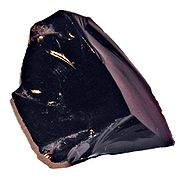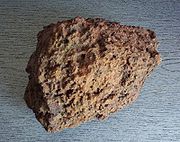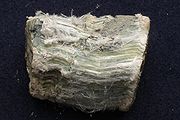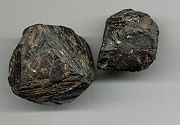.gif)
Fracture (mineralogy)
Encyclopedia
In the field of mineralogy
, fracture is a term used to describe the shape and texture of the surface formed when a mineral
is fractured
. Minerals often have a highly distinctive fracture, making it a principal feature used in their identification.
Fracture differs from cleavage
in that the latter involves clean splitting along the cleavage planes of the mineral's crystal structure
, as opposed to more general breakage. All minerals exhibit fracture, but when very strong cleavage is present, it can be difficult to see.
 Conchoidal fracture
Conchoidal fracture
is a curved breakage that resembles the concentric ripples of a mussel
shell. It often occurs in amorphous or fine-grained minerals such as flint
, opal
or obsidian
, but may also occur in crystalline minerals such as quartz
. Subconchoidal fracture is similar to conchoidal fracture, but not as curved.
 Earthy fracture is reminiscent of freshly broken soil
Earthy fracture is reminiscent of freshly broken soil
. It is frequently seen in relatively soft, loosely bound minerals, such as limonite
, kaolinite
and aluminite
.
.jpg) Hackly fracture (also known as jagged fracture) is jagged, sharp and uneven. It occurs when metals are torn, and so is often encountered in native metal
Hackly fracture (also known as jagged fracture) is jagged, sharp and uneven. It occurs when metals are torn, and so is often encountered in native metal
s such as copper
and silver
.
 Splintery fracture comprises sharp elongated points. It is particularly seen in fibrous minerals such as chrysotile
Splintery fracture comprises sharp elongated points. It is particularly seen in fibrous minerals such as chrysotile
, but may also occur in non-fibrous minerals such as kyanite
.
 Uneven fracture is self descriptive. It occurs in a wide range of minerals including arsenopyrite
Uneven fracture is self descriptive. It occurs in a wide range of minerals including arsenopyrite
, pyrite
and magnetite
.
Mineralogy
Mineralogy is the study of chemistry, crystal structure, and physical properties of minerals. Specific studies within mineralogy include the processes of mineral origin and formation, classification of minerals, their geographical distribution, as well as their utilization.-History:Early writing...
, fracture is a term used to describe the shape and texture of the surface formed when a mineral
Mineral
A mineral is a naturally occurring solid chemical substance formed through biogeochemical processes, having characteristic chemical composition, highly ordered atomic structure, and specific physical properties. By comparison, a rock is an aggregate of minerals and/or mineraloids and does not...
is fractured
Fracture
A fracture is the separation of an object or material into two, or more, pieces under the action of stress.The word fracture is often applied to bones of living creatures , or to crystals or crystalline materials, such as gemstones or metal...
. Minerals often have a highly distinctive fracture, making it a principal feature used in their identification.
Fracture differs from cleavage
Cleavage (crystal)
Cleavage, in mineralogy, is the tendency of crystalline materials to split along definite crystallographic structural planes. These planes of relative weakness are a result of the regular locations of atoms and ions in the crystal, which create smooth repeating surfaces that are visible both in the...
in that the latter involves clean splitting along the cleavage planes of the mineral's crystal structure
Crystal structure
In mineralogy and crystallography, crystal structure is a unique arrangement of atoms or molecules in a crystalline liquid or solid. A crystal structure is composed of a pattern, a set of atoms arranged in a particular way, and a lattice exhibiting long-range order and symmetry...
, as opposed to more general breakage. All minerals exhibit fracture, but when very strong cleavage is present, it can be difficult to see.
Conchoidal fracture

Conchoidal fracture
Conchoidal fracture describes the way that brittle materials break when they do not follow any natural planes of separation. Materials that break in this way include flint and other fine-grained minerals, as well as most amorphous solids, such as obsidian and other types of glass.Conchoidal...
is a curved breakage that resembles the concentric ripples of a mussel
Mussel
The common name mussel is used for members of several families of clams or bivalvia mollusca, from saltwater and freshwater habitats. These groups have in common a shell whose outline is elongated and asymmetrical compared with other edible clams, which are often more or less rounded or oval.The...
shell. It often occurs in amorphous or fine-grained minerals such as flint
Flint
Flint is a hard, sedimentary cryptocrystalline form of the mineral quartz, categorized as a variety of chert. It occurs chiefly as nodules and masses in sedimentary rocks, such as chalks and limestones. Inside the nodule, flint is usually dark grey, black, green, white, or brown in colour, and...
, opal
Opal
Opal is an amorphous form of silica related to quartz, a mineraloid form, not a mineral. 3% to 21% of the total weight is water, but the content is usually between 6% to 10%. It is deposited at a relatively low temperature and may occur in the fissures of almost any kind of rock, being most...
or obsidian
Obsidian
Obsidian is a naturally occurring volcanic glass formed as an extrusive igneous rock.It is produced when felsic lava extruded from a volcano cools rapidly with minimum crystal growth...
, but may also occur in crystalline minerals such as quartz
Quartz
Quartz is the second-most-abundant mineral in the Earth's continental crust, after feldspar. It is made up of a continuous framework of SiO4 silicon–oxygen tetrahedra, with each oxygen being shared between two tetrahedra, giving an overall formula SiO2. There are many different varieties of quartz,...
. Subconchoidal fracture is similar to conchoidal fracture, but not as curved.
Earthy fracture

Soil
Soil is a natural body consisting of layers of mineral constituents of variable thicknesses, which differ from the parent materials in their morphological, physical, chemical, and mineralogical characteristics...
. It is frequently seen in relatively soft, loosely bound minerals, such as limonite
Limonite
Limonite is an ore consisting in a mixture of hydrated iron oxide-hydroxide of varying composition. The generic formula is frequently written as FeO·nH2O, although this is not entirely accurate as limonite often contains a varying amount of oxide compared to hydroxide.Together with hematite, it has...
, kaolinite
Kaolinite
Kaolinite is a clay mineral, part of the group of industrial minerals, with the chemical composition Al2Si2O54. It is a layered silicate mineral, with one tetrahedral sheet linked through oxygen atoms to one octahedral sheet of alumina octahedra...
and aluminite
Aluminite
For the igneous rock type "websterite", see pyroxenite.Aluminite is a hydrous aluminium sulfate mineral with formula: Al2SO44·7. It is an earthy white to gray-white monoclinic mineral which almost never exhibits crystal form. It forms botryoidal to mammillary clay-like masses. It is very soft Mohs...
.
Hackly fracture
.jpg)
Native Metal
A native metal is any metal that is found in its metallic form, either pure or as an alloy, in nature. Metals that can be found as native deposits singly and/or in alloys include aluminium, antimony, arsenic, bismuth, cadmium, chromium, cobalt, indium, iron, nickel, selenium, tantalum, tellurium,...
s such as copper
Native copper
Copper, as native copper, is one of the few metallic elements to occur in uncombined form as a natural mineral, although most commonly occurs in oxidized states and mixed with other elements...
and silver
Silver
Silver is a metallic chemical element with the chemical symbol Ag and atomic number 47. A soft, white, lustrous transition metal, it has the highest electrical conductivity of any element and the highest thermal conductivity of any metal...
.
Splintery fracture

Chrysotile
Chrysotile or white asbestos is the most commonly encountered form of asbestos, accounting for approximately 95% of the asbestos in place in the United States and a similar proportion in other countries. It is a soft, fibrous silicate mineral in the serpentine group of phyllosilicates; as such, it...
, but may also occur in non-fibrous minerals such as kyanite
Kyanite
Kyanite, whose name derives from the Greek word kuanos sometimes referred to as "kyanos", meaning deep blue, is a typically blue silicate mineral, commonly found in aluminium-rich metamorphic pegmatites and/or sedimentary rock. Kyanite in metamorphic rocks generally indicates pressures higher than...
.
Uneven fracture

Arsenopyrite
Arsenopyrite is an iron arsenic sulfide . It is a hard metallic, opaque, steel grey to silver white mineral with a relatively high specific gravity of 6.1. When dissolved in nitric acid, it releases elemental sulfur. When arsenopyrite is heated, it becomes magnetic and gives off toxic fumes...
, pyrite
Pyrite
The mineral pyrite, or iron pyrite, is an iron sulfide with the formula FeS2. This mineral's metallic luster and pale-to-normal, brass-yellow hue have earned it the nickname fool's gold because of its resemblance to gold...
and magnetite
Magnetite
Magnetite is a ferrimagnetic mineral with chemical formula Fe3O4, one of several iron oxides and a member of the spinel group. The chemical IUPAC name is iron oxide and the common chemical name is ferrous-ferric oxide. The formula for magnetite may also be written as FeO·Fe2O3, which is one part...
.

